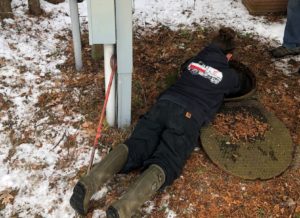How does a septic system work?
A septic system is a type of small-scale sewage treatment system that is common in areas with no connection to main sewage pipes provided by local governments or private corporations. It’s especially prevalent in rural areas. Here’s a basic description of how it works:
- Wastewater leaves your home: All the water you use in your home, from the toilet, shower, washing machine, dishwasher, etc., flows into the septic tank.
- Primary treatment in the septic tank: The septic tank is a buried, water-tight container usually made of concrete, fiberglass, or polyethylene. Its job is to hold the wastewater long enough to allow solids to settle down to the bottom (forming sludge) while the oil and grease floats to the top (as scum). In the tank, anaerobic bacteria, which does not require oxygen, begin breaking down the organic material in the wastewater.
- Secondary treatment in the drain field: The liquid wastewater (effluent) then exits the tank into a drain field (also called a leach field or soil absorption field). The drain field is a shallow, covered excavation made in unsaturated soil. The soil provides the final treatment and disposal of the septic tank effluent. After the effluent has passed into the soil, most of it percolates downward and outward, eventually entering the groundwater. The soil acts as a biological filter, removing harmful bacteria, viruses, and nutrients, such as nitrogen and phosphorous, which can harm local waterways.
- Return to the environment: After treatment, the water is returned to the groundwater system.
It’s important to note that a septic system requires regular maintenance and inspection to ensure that it continues to function properly. The tank needs to be pumped periodically to remove the solids (sludge and scum). If not removed, these solids will build up in the tank and can clog the drain field pipes, causing the system to fail. The frequency of pumping depends on several factors, such as the size of the tank, the volume of wastewater, and the amount of solids in the wastewater.
What are inappropriate things to flush into a septic system?
To keep a septic system functioning properly, it’s important to be mindful of what goes down your drains. Here’s a list of items you should avoid flushing into a septic system:
- Non-biodegradable items: This includes items like diapers, baby wipes, sanitary napkins, tampons, condoms, cigarette butts, and plastic items. These will not break down and can clog the system or fill the tank, necessitating more frequent pumping.
- Chemicals: Harsh chemicals can kill the beneficial bacteria in the septic tank that break down waste. This includes paints, varnishes, thinners, waste oils, photographic solutions, and other harsh cleaning products. Even small amounts of these can cause damage.
- Medications: Pharmaceuticals can disrupt the balance of bacteria in the septic system and contaminate the groundwater. It’s best to dispose of unwanted medications through a local take-back program or by following FDA guidelines.
- Fats, oils, and grease (FOG): These can solidify and clog the pipes leading to your septic tank or create a layer of scum in the tank that prevents the normal breakdown of waste.
- Food waste: While small amounts are okay, excessive food waste (especially from a garbage disposal) can increase the solids in the tank and require more frequent pumping. Certain types of food waste, like coffee grounds, eggshells, and fruit and vegetable peels, take a long time to decompose and can contribute to sludge buildup.
- Cat litter: Even if it’s labeled as “flushable,” cat litter can clog the pipes and add solids to the tank. Cat feces can also contain a parasite harmful to humans that may not be effectively removed by the septic system.
- Paper products other than toilet paper: Items like paper towels, facial tissues, and even thicker types of toilet paper can take a long time to decompose and cause clogs.
Remember, your septic system is not a trash can. The only things that should go into it are wastewater and toilet paper. Everything else should be disposed of properly elsewhere. Regular maintenance, including pumping and inspection, is also important to keep your septic system in good working order.
How does a septic system fail?
Septic systems can fail for a variety of reasons, often due to neglect and improper maintenance. Here are some common causes of septic system failure:
- Insufficient Maintenance: Septic tanks need to be pumped regularly to remove the build-up of solids. If this isn’t done, the solids can overflow into the drain field, clogging it. This is one of the most common causes of septic system failure.
- Excessive Water Use: If too much water flows into a septic tank over a short period, it can overwhelm the system. The water can stir up solids in the tank, allowing them to escape into the drain field and clog it.
- Chemical Damage: Certain chemicals, like solvents, oils, pesticides, and high-strength cleaners, can kill the bacteria in the septic tank that are necessary for breaking down waste.
- Physical Damage: If vehicles drive over the drain field, it can compact the soil or damage the pipes. Tree roots can also infiltrate and clog the pipes.
- Improper Design or Installation: If a septic system is not designed or installed correctly, it can lead to failure. For example, the tank or drain field might be too small for the amount of water used in the home, or the drain field might not be suitable for the type of soil present.
- Flushing Inappropriate Items: As mentioned in the previous response, flushing inappropriate items like diapers, wipes, feminine hygiene products, or non-degradable items can clog the system and lead to failure.
When a septic system fails, it can result in sewage surfacing in the yard, sewage backing up into the house, slow drains, gurgling pipes, or lush, green growth over the drain field. Bad odors are also a common sign. These situations are not only unpleasant but can also pose serious health risks due to exposure to raw sewage. If you suspect your septic system has failed, you should contact a professional for an evaluation as soon as possible.
If you have questions about your septic system design or are looking to install a new one, give TCE a call at 802-879-6331 or contact us online





